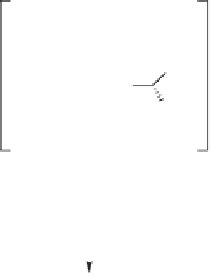Chemistry Reference
In-Depth Information
(OC)
3
Co
Co(CO)
3
(CO)
3
Co
Co
2
(CO)
8
O
O
(OC)
3
Co
Ph
Ph
Ph
Cl
K
2
CO
3
N
N
Toluene, 0
°
C to rt
Ph
Cl
Me
45%
12
Ph
Me
NMO,
0 ºC, 20 min
O
NMO
N
Me
O
Ph
O
Ph
N
13
(64%, 1.4:1 dr)
O
Me
Scheme 5.20
5.2.4 Chiral
O
-Alkyl Enol Ethers
The first enantioselective synthesis of a natural product by means of a chiral auxiliary-
mediated intramolecular PKR was reported in 1990 by Moyano, Pericas, Greene, and
co-workers.
28
The chemo- and stereoselective reduction of 1-alkoxyacetylenes into (
E
)-
or (
Z
)-
O
-alkyl enol ethers
14, 29
enabled the easy preparation of enynes
14a
-
14d
, derived
from (1
S
,2
R
)-2-phenylcyclohexanol. These compounds were stirred with 1.1 equivalents
of dicobalt hexacarbonyl in isooctane at room temperature, and the resultant dicobalt
hexacarbonyl complexes, without isolation, were then heated at 95
◦
C for 1-5 h. The (
E
)
enol ethers
14a
,
14c
, and
14d
were cyclized in acceptable yields and with moderate to
good diastereoselectivity (up to 7:1 dr; Scheme 5.21). It is clear that the fact that in this
approximation, contrary to that relying in the cyclization of 1-alkoxyenynes (see Table
5.1 above),
16
the newly created stereogenic center is immediately adjacent to the carbon
bearing the chiral auxiliary, leads to a higher degree of stereocontrol.
Ph
O
H
Ph
Co
2
(CO)
8
O
X
O
X
Isooctane or
hexane, rt, 1.5 h;
reflux, 1-5 h
R
R
(Major isomer)
14a
(X = CH
2
, R = H)
14c
(X = O, R = H)
14d
(X = O, R = Me)
15a
(X = CH
2
, R = H): 55%,7:1 dr
15c
(X = O, R = H): 41%, 4.5:1 dr
15d
(X = O, R = Me): 42%, 4:1 dr
Scheme 5.21































































